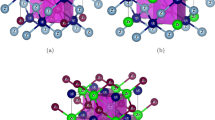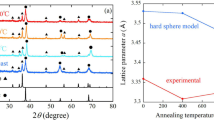Summary
The quench-enhanced ordering effects in Fe 50-Ni 50 are studied by means of measurements of electrical resistivity, Mössbauer effect and induced anisotropy energy. From the change of resistivity and Mössbauer spectra observed after isothermal annealings between 100 and 300 °C it is suggested that two different processes probably occur in the quenched alloy: partial ordering and some clustering or precipitation of iron-rich regions possibly corresponding to a very small fraction of an α-Fe phase. Furthermore, the very high magnetic anisotropy energyK u (< 104 erg/cm3) induced by magnetic annealing at 300 °C, and the experimentally observedK u temperature dependence seem to confirm the formation of a small quantity of α-Fe phase precipitations, or in any case of iron-rich clusters.
Riassunto
Mediante misure di resistività elettrica, di anisotropia magnetica indotta ed effetto Mössbauer si è studiata la diffusione stimolata da tempra in leghe FeNi 50–50. Dalla variazione della resistività e dei risultati degli spettri Mössbauer dopo ricottura fra 100 e 300 °C si può suggerire che probabilmente si producono due diversi processi nella lega: un parziale riordinamento ed alcuni cluster o precipitati di ferro che possono corrispondere ad una precipitazione di fase α ricca in ferro. Inoltre la ricottura magnetica a 300° induce, nella lega temprata, un’elevata energia di anisotropia magneticaK u , dell’ordine di 104erg.cm3 ed i valori osservati sperimentalmente diK u in funzione della temperatura sembrano confermare la formazione di una piccola quantità di fase α precipitata, o in ogni caso di cluster ricchi di ferro.
Резюме
Посредством измерен ий электрического сопротивления, эффек та Мёссбауера и энергии наведенной анизотро пии исследуется влияние закалки, увеличивающ ей упорядочение в сплав е Fe 50-Ni 50. Исходя из изменен ия сопротивления и спектров Мёссбауер а, наблюденных после изотермического отж ига между 100 и 300 °С, можно предположит ь, что, вероятно, в зака ленном сплаве протекают два различных процесса: ч астичное упорядочен ие и некоторое группиров ание или осаждение областей богатых жел езом, возможно, соотве тствующих очень малой доле фазы gа-Fе. Кроме того, оч ень высокая энергия м агнитной анизотропии Ku (< 104 эрг/см3), индуцирован ная вследствие магни тного отжига при 300 °С, и экспе риментально наблюденная темпера турная зависимость Ku, по-видимому, подтверж дают образование небольш ого количества осажд енной фазы α-Fe, или, во всяком случае, класте ров богатых железом.
Similar content being viewed by others

References
J. Paulevè, D. Dautreppe, J. Laugher andL. Néel:Compt. Rend.,254, 965 (1962).
L. Nèel, J. Paulevè, K. Pauthenet, J. Laugier andD. Dautreppe:Journ. Appl. Phys.,35, 873 (1964).
J. Paulevè, K. Krebs, A. Chamberod andJ. Laugier:Compt. Rend.,260, 2439 (1965).
J. Paulevè, A. Chambereod, K. Krebs andA. Marchand :IEEE Trans, on Magnetics, MAG-2, 475 (1966).
A. Chamberod andJ. Paulevè:Journ. Phys. Chem. Solids,29, 1683 (1968).
A. Ferro andG. Griffa:Journ. Phys. Chem. Solids,31, 2789 (1970).
E. A. Nesbitt, B. W. Batterman, L. D. Fullerton andA. J. Williams:Journ. Appl. Phys.,36, 1235 (1965).
A. Ferro, G. Griffa andG. Montalenti:IEEE Trans. on Magnetics, MAG-2, 764 (1966).
M. Hansen:Construction of Binary Alloys (New York, 1968).
A. C. Damask andG. J. Dienes:Point Defects in Solids (New York, 1963), p. 46.
S. Benci, G. Gasparrini andE. Germagnoli:Nuovo Cimento,31, 1165 (1964).
A. Seeger andD. Schumacher: inLattice Defects in Quenched Metals, edited byE. M. J. Cotterill et al. (New York, 1965), p. 54.
A. Marchand andA. Chamberod:Compt. Rend.,261, 8113 (1965).
A. J. Schindler, R. H. Kernohan andJ. Weertman:Journ. Appl. Phys.,35, 2640 (1964).
A. Ferro andG. P. Soardo:Journ. Appl. Phys.,40, 3051 (1969).
Y. Gros andJ. C. Pebay-Peyroula:Phys. Lett.,13, 5 (1964);Journ. de Phys.,31, 459 (1970).
W. Zinn, M. Kalvius, E. Kankeleit, P. Kienle andW. Wiedemann:Journ. Phys. Chem. Solids,24, 993 (1963).
E. T. Fergusson:Journ. Appl. Phys.,29, 252 (1958).
S. Kaya:Rev. Mod. Phys.,25, 49 (1953).
A. Ferro, P. Mazzetti andG. Montalenti: in press inJourn. de Phys.
Author information
Authors and Affiliations
Additional information
To speed up publication, the authors of this paper have agreed to not receive the proofs for correction.
Rights and permissions
About this article
Cite this article
Ferro, A., Griffa, G. & Ortalli, I. On quench-enhanced ordering of Fe 50-Ni 50 alloy. Nuov Cim B 3, 269–280 (1971). https://doi.org/10.1007/BF02815341
Received:
Published:
Issue Date:
DOI: https://doi.org/10.1007/BF02815341



